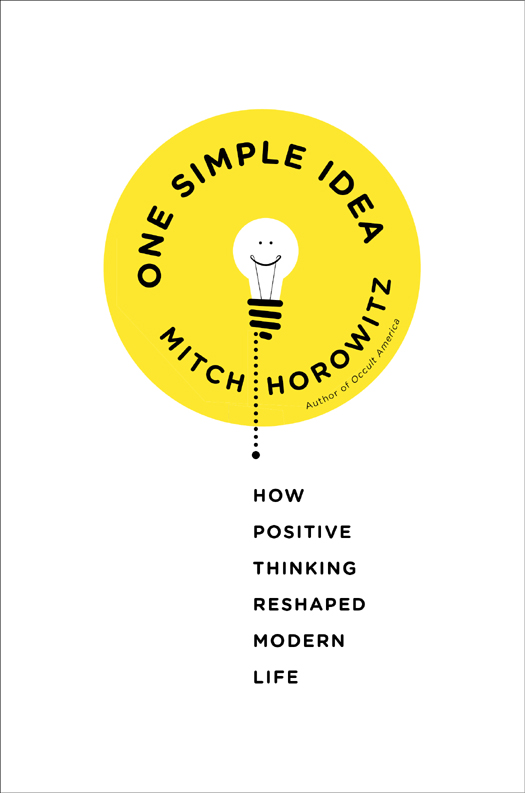
One Simple Idea
How Positive Thinking Reshaped Modern Life
کتاب های مرتبط
- اطلاعات
- نقد و بررسی
- دیدگاه کاربران
نقد و بررسی

October 7, 2013
When his family life collapsed during his teenage years, Horowitz, vice president and editor-in-chief at Penguin/Tarcher, wished, prayed, read Emerson and the Talmud, and clung to the hope that a better attitude could improve his situation. When his family’s situation did improve, he grew to believe that his positive thinking had contributed and could continue to help steer him through rough waters. Taking the cue from his own experience, Horowitz offers a spell-binding survey of the evolution and persistence of positive thinking and its shaping of modern America, where its influence is felt in the messages of preachers T.D. Jakes and Joel Osteen, in Ronald Reagan’s slogan “nothing is impossible,” and in commercial taglines, such as Nike’s “Just Do It.” Horowitz’s survey begins with 19th-century Maine clockmaker Phineas Quimby, who healed himself with a combination of vigorous physical activity and mind-over-matter techniques, before treating others, including the future Mary Baker Eddy. Horowitz then follows the trail from Eddy through figures like Prentice Mulford, who advocated the mind’s “wealth-building potential”; James Allen, who blended religion with motivational thought; friend-winner and people-influencer Dale Carnegie; and Alcoholics Anonymous founders Bill Wilson and Bob Smith. Horowitz, with an ear towards critics, cannily probes the roots of positive thinking through to modern science.

December 1, 2013
The evolution of the positive-thinking movement. In present-day society, the philosophy of positive thinking is ubiquitous. But where did this belief system come from? In extensive detail, Tarcher/Penguin vice president and editor in chief Horowitz (Occult America: White House Seances, Ouija Circles, Masons and the Secret, Mystic History of Our Nation, 2010) examines the developmental process of positive thinking from the late 1700s to today. When New England clockmaker Phineas Quimby took a "frenetic carriage ride" in 1833 across the Maine countryside, he suddenly realized that the ensuing exhilaration relieved his tuberculosis symptoms. Blending this new, positive thought process with the practice of mesmerism or hypnosis, Quimby began treating the sick through mental methods. Based on his work, a student founded the practice of Christian Science and was followed by others who delved into metaphysical studies. During the ensuing decades, other movements began to develop, and influential people, including Ronald Reagan, promoted the philosophy of mindful thinking and believed in "America's divine purpose and of a mysterious plan behind the nation's founding." Horowitz also examines the modern tactics outlined in The Secret and the mind-body connection found in the discipline of quantum mechanics. Though more a historical analysis than a definitive text on whether the practice actually works, the author does claim, "[t]he wish to authentically search for the self and its true aims is, perhaps, the greatest form of mental affirmation to which a person can aspire, and the one that brings the most help." Based on the all-encompassing information Horowitz provides, as well as his extensive notes that add further depth to the conversation, any scholar interested in this field should have no trouble making his or her own decision on the subject. A historically rich analysis of an idea that is older than many may think.
COPYRIGHT(2013) Kirkus Reviews, ALL RIGHTS RESERVED.

November 1, 2013
Horowitz (vice president & editor in chief, Tarcher/Penguin; Occult America) tracks the development of the positive-thinking movement from its roots in late 18th-century New England to its current incarnations, e.g., Joel Osteen's preaching and writings and Rhonda Byrne's The Secret. By the 1920s, spiritual self-help, promoted in books such as James Allen's As a Man Thinketh (1902), which is still read today, led religious congregants to desire a "usefulness" from their faith, which in turn led to the rapid rise of organizations and programs combining scientific, self-help, and religious ideas. By the end of World War II, the idea of positive thinking, having established its religious roots, entered the mainstream and led to new views in business, psychotherapy, and even politics. Horowitz writes that he both loves the movement for its "sense of possibilities, its challenge to religious conformity, and its practical ideas" and disdains it for its "lack of moral rigor, its inconsistencies, and its intellectual laxity." But he notes studies in neuroscience that are addressing the role of human thought in representing--and even shaping--reality. Readers will see how Christian Science, Norman Vincent Peale's The Power of Positive Thinking, and 12-step programs are all branches on the tree of positive thinking. VERDICT This deftly crafted history will leave readers with a rich understanding of the subject and even some curiosity about its potential application to their own lives.--Elizabeth Winter, Georgia Inst. of Technology Lib., Atlanta
Copyright 2013 Library Journal, LLC Used with permission.

December 15, 2013
This is not yet another book purporting to tell you how to harness the power of positive thinking to improve your life. Instead, it's a history of the positive-thinking movement. Beginning with German physician Franz Mesmer's popular (but eventually discredited) theories of animal magnetism and moving through tuberculosis survivor Phineas Quimby (who realized the power to heal oneself came from the mind and not from an invisible fluid in the body) to Mary Baker Eddy (a Quimby patient who would go on to found Christian Science), Norman Vincent Peale in the mid-twentieth century, and on to contemporaries Joel Osteen, Tony Robbins, and Mehmet Oz, the author explores the way the idea of positive thinking has shifted and evolved as new hands touched it. Even those who are critical of the positive-thinking movement, or New Thought, as it's sometimes knownthat appellation was coined by Ralph Waldo Emersonare likely to agree that this is a well-researched, thoughtful, and frequently surprising history of the subject. It's unlikely to change skeptics' minds, but that's not the point anyway: the point is to educate and inform, and the author does that splendidly.(Reprinted with permission of Booklist, copyright 2013, American Library Association.)

























دیدگاه کاربران